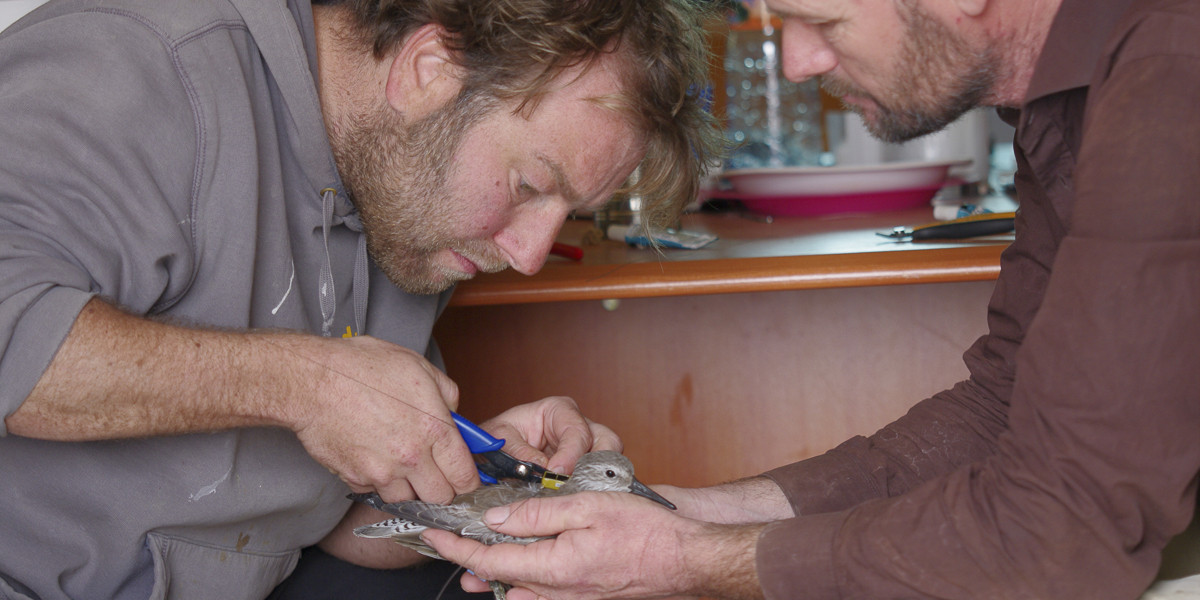FOR ENGLISH VERSION SEE BELOW
Tekst: Rob Buiter
Uit de lucht
Het zit de Mauritaanse kanoeten niet mee. Of beter gezegd: het zit de onderzoekers van de Mauritaanse kanoeten niet mee. Van alle aangebrachte satellietzenders is er nog maar ééntje ‘in de lucht’. Voor de satellietgegevens door de NIOZ-onderzoekers op het web kunnen worden gezet, worden ze door de Amerikaanse ecologe Lee Tibbitts, van de United States Geological Survey in Anchorage, Alaska‘ van de satelliet gehaald’. Haar meest recente overzicht laat ze vergezeld gaan van een helder understatement: ‘not looking too good, unfortunately.’
Kinderziektes
‘De twee-grams zenders van het bedrijf Microwave zijn nog maar heel kort op de markt. Feitelijk zijn het nog proto-types’, zo licht Tibbitts toe. Zelf heeft zij deze week nog een tiental van deze zelfde zendertjes aangebracht op blonde ruiters. ‘Het probleem lijkt te zitten in het bevestigingsmechanisme. De tuigjes zijn zó klein dat je daar geen knoopjes in kan leggen. Je moet de dunne metaaldraadjes met hun siliconen coating als het ware dichtknijpen met een minuscuul metalen clipje. Ervaringen uit Australië met andere steltlopers leren nu dat je bij het dichtknijpen van die clipjes misschien de coating beschadigt. Daardoor komen de dunne draadjes bloot te staan aan de invloeden van zout en water. Waarschijnlijk kunnen ze dat niet al te lang hebben’, aldus Tibbitts.

Dure lessen
Het lijkt bij het leven van pionierende ecologen te horen. ‘Het is een waardevolle les. Geen leuke, maar toch.’ Tegelijk houdt Tibbitts nog wel een kleine slag om de arm. ‘Heel misschien zit het probleem wel in de zonnepaneeltjes. Als de zenders pas voldoende zonlicht – en dus stroom – krijgen wanneer de kanoeten op trek gaan, komen ze misschien een dezer dagen weer on air. Maar de kans lijkt me helaas toch groter dat de zendertjes ergens tussen het zeegras op de Mauritaanse vlakten liggen.’
Als dat zo is, verwacht Tibbitts voor de kanoeten zelf verder geen hinder. ‘Met een beetje geluk zien jullie ze volgende winter op enig moment weer terug, en kun je aan de kleurringen herkennen dat het de vogels nog steeds goed gaat. Maar dan zonder zender op hun rug.’
ENGLISH VERSION:
Off air
For Mauritanian knots things are not going their way. Or better said: luck does not hold for the Mauritanian knot researchers. Of all satellite transmitters, only a single one is still ‘on air’. Before NIOZ researchers are able to put satellite data on the web, they are ‘read from the satellite’ by American ecologist Lee Tibbitts, from the United States Geological Survey in Anchorage, Alaska. Her most recent overview is accompanied by a clear understatement: ‘not looking too good, unfortunately.’
Start-up problems
‘The two-gram transmitters of the company Microwave have entered the market very recently. In fact, they are still prototypes’, says Tibbitts. This week, she personally has equipped a dozen of buff-breasted sandpipers with the very same transmitters. ‘The problem seems to be in the fastening mechanism. The ropes are so small that you cannot tie any knots in them. You must pinch, as it were, the thin metal wire with their silicone coating with a tiny metal clip. Experiences from Australia with other shorebirds now reveal that you can damage the coating when squeezing those clips. As a result, the thin wires are exposed to the impacts of salt and water. Probably they may not take that too long, ' said Tibbitts.
Expensive lessons
That’s life for pioneering ecologists, so it seems. 'It's a valuable lesson. Not an enjoyable one, but still.' At the same time, Tibbitts still holds little room for the unknown. 'There is a slight possibility that the problem lies in the solar panels. If the stations would only get enough sunlight — and thus power — when the knots start to migrate, they may come ‘on air’ again these days. But, unfortunately, the odds seem to me that the transmitters hide somewhere in the Mauritanian seagrass beds.'
Even if that is the case, Tibbitts expects no further obstacles to the knots themselves. ‘With a little luck, you'll retrieve them back in winter at some point, and you can recognize by their colours that the birds are still doing well. Be it without a transmitter on their back.'